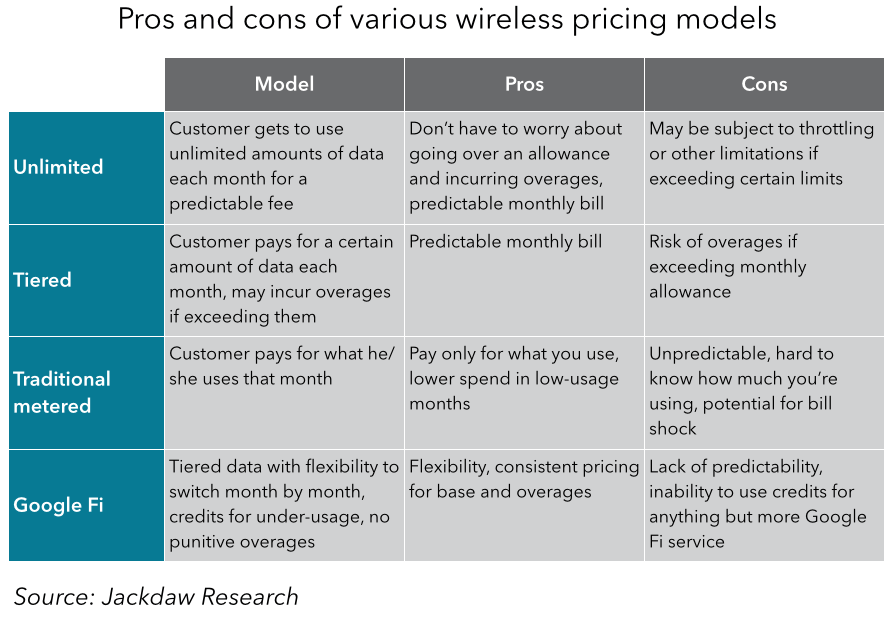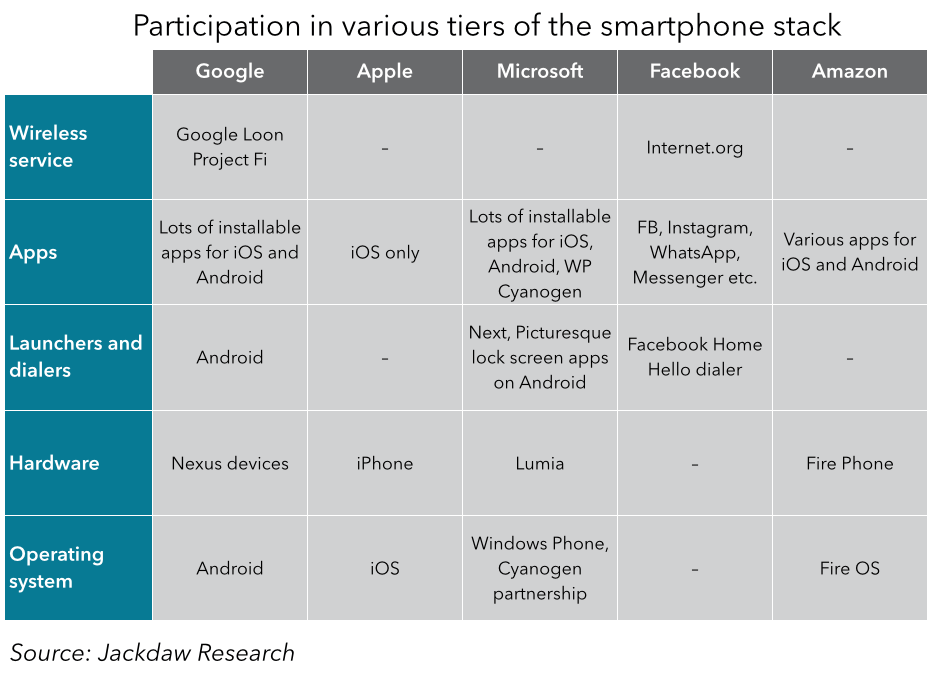Yesterday, Google finally announced the wireless service that’s been reported for months. Named Project Fi, it acts as a somewhat unique MVNO, piggybacking off both Sprint and T-Mobile’s networks as well as making heavy use of around a million WiFi hotspots. Reporters have been covering many angles of this news and I’ve talked to a few of them. Today, I thought I’d share a little of how I view what’s actually been launched. Incidentally, we talked about Google’s MVNO ambitions on the Techpinions podcast back in January and a transcript of my remarks can be found here.
Limited by design
First off, the Project Fi service is limited, by design, in several ways. It’s only available on one device, the Nexus 6. This device has a tiny market share today but, if you wanted to, you could buy one from Google’s Play Store for $649 and up, or Google will finance it for you as the carriers now typically do (interestingly, something I foresaw here). But it’s also an enormous device, far larger than most phones ordinary people carry, especially in the US. As such, the addressable market is hemmed in. But it’s limited to this one device because the service requires compatibility with both the Sprint and T-Mobile networks and no other device supports both. In theory, Google could launch additional devices over time to run on the service, but it may have a tough time getting OEMs to build devices just for the service when it has very few subscribers. Neither Sprint nor T-Mobile is likely to launch such devices themselves, so Google is basically on its own here. It has neither a track record nor the infrastructure to sell large numbers of devices, so I’m skeptical it can grow.
Google is also using an invite-based approach to signing up users and captures both a Gmail address and Zip Code during the application process. This means it will both roll out the service very slowly and in such a way users are likely to get good coverage where they live. Sprint and T-Mobile have the worst coverage of the four major operators in the US, but combining their networks is a clever way to fill in gaps. I see Fi at this point as being something like the early betas of Google’s other services such as Gmail. Many of those services stayed in beta mode for quite some time and, though it doesn’t have the label officially, I can see Fi doing the same, opening up only slowly to customers. That’s likely a good thing – it takes a lot of back-end infrastructure to run a mobile operator, even one without a network, and that infrastructure has to scale with customers.
Pricing – simple but not necessarily disruptive
Project Fi’s pricing is a little different from standard wireless pricing – it’s simple, but not necessarily cheaper, especially for certain users. Partly because there are no subsidies or other complications and partly because Google only does single-line plans, the pricing is simple: $20 as a base price for unlimited talk and text and $10 for each gigabyte of data. The model also provides credits for using less than the planned amount. This makes it, in some ways, more like traditional metered plans than anything on the market today, as this table shows:

There’s a reason we moved away from metered pricing some time ago and it’s that metered pricing tends to inhibit usage. Unlimited is the most freeing model of all, because it removes all worries about incurring overages or having to curtail usage. But it’s impractical on most networks because of the potential for abuse and most carriers have tended to focus on tiered pricing, which provides a compromise between predictability and network management. Google Fi shares some characteristics of both tiering and traditional metered usage – at the end of the day, the results will be more like metered usage, but the presentation feels more like tiering. It’s an interesting compromise, but I’m concerned it’s going to be tough for customers to know how much data they’re using at any given time, especially since Fi tends to hop onto WiFi.
For anyone who’s used to multi-line plans, Google’s service pricing will be less attractive, because it provides no discounts for additional lines. As such, a family using an average amount of data is likely to find Google’s pricing relatively uncompetitive. And that’s not surprising – because Google is piggybacking off Sprint and T-Mobile’s network, it’s paying the very companies it’s competing with and they’re never going to enable it to undercut them significantly on price. That’s one of the fundamental rules of MVNOs.
Why is Google doing this?
Given the limitations I’ve described above, the question becomes: why is Google doing this? I think there are a couple of reasons:
- first, there’s an element of experimentation akin to what it has done with Google Fiber
- second, this is Google’s attempt to create a full-stack experience on mobile.
The first point is simple. Google Fiber has done two things for Google: it’s enabled it to experiment in a very cost-effective way with new broadband and TV services on a very limited scale and learn something about user behavior in the process. Second, it’s provided a much more aggressive form of competition to the local duopolies that provide broadband in many places around the US. The latter has caused incumbents to up their speeds and/or lower their prices to compete. But it’s only happened on a very localized basis, because Google Fiber is only available in very few places. In some ways, Google Fi is similar in it’s a potentially disruptive model, but offered on a very limited scale. However, unlike Google Fiber, which can at least have a big impact on a local level, it’s hard to see Google Fi having any sort of significant impact on the US wireless market – it’s simply going to be too marginal, at least for now.
The other reason is more interesting and it goes back to something Sundar Pichai of Google said at Mobile World Congress earlier this year:
The core of Android and everything we do is to take an ecosystem approach and [a network would have] the same attributes.
This was before we knew the details of Project Fi, but it’s a clear signal of what Project Fi has ended up being: an end-to-end, full-stack, Google approach to a smartphone. To understand how significant that is, it’s helpful to understand how Google operates today in the smartphone market. This is illustrated in a simplified fashion in the diagram below:
When it comes to Android, Google is like a parent sending a child off to college – it has done its best to prepare them for the real world but has very little control over what they actually get up to once they walk out the door. Google licenses Android to OEMs, which in turn customize the OS and layer on their own services, features and UI elements, and then, once carriers get involved, they often force further customization and pre-installed apps of their own. By the time Android reaches consumers, it can be very different from what Google created and it has very little control over all that, though it’s been trying to rein in some of the customizations lately. Apple, by contrast, controls the experience from top to bottom and largely dictates to the carriers in terms of how the product is packaged and sold.
An Apple-like level of control over this stack is appealing, because it allows the company to manage the experience its customers have to a far greater extent. Part of Google’s challenge is carriers embraced it in the early years precisely because they saw it as something that could be molded to fit their needs and they’ve largely used it in that way. Whether to fight off the iPhone, to offer lower-cost smartphones, or to push their own apps and services. All this goes against Google’s real mission for Android, which is to put in consumers’ hands a Google ecosystem, which takes us back to Sundar Pichai’s remarks. Android was created as an ecosystem, but it largely exists within OEM and carrier ecosystems and its appeal and effectiveness as an ecosystem is limited by their involvement. What Google Fi does for Google is to free it from these encumbrances and allow the user to have an all-Google experience on their smartphone. It’s interesting to put this in the context of the various efforts by companies to control elements of the smartphone stack:
As you can see, Google is the only company here that’s working all the way up and down this stack in various ways. In the case of Project Fi, it controls the hardware, the software (stock Android), apps and services which are unique to Android and to Project Fi, and now the wireless connectivity around it. This is, for better or worse, an all-Google experience out of the box, for the first time. And Google, of course, also controls the retail channel for all this. The big question for Google – as it was for Amazon with the Fire Phone – is to what extent people want such an experience, and whether they want it badly enough to justify putting up with the current limitations of the service. It’s an interesting experiment in the short term, but I’m just not convinced at this point it can achieve any sort of mass appeal or adoption unless some things change pretty dramatically.

Google is only doing this to harvest user analytics. Signing up for this service means Google tracking you and analyzing what you’re doing and where you’re doing it at all times. This has nothing to do with offering a superior service or doing a favour to consumers by providing another choice. It’s about one thing only: harvesting data on you and selling it to advertisers. Just another example of how even when paying Google for a service, you’re not the actual customer – advertisers are. Combining two weak wireless network operators for use on a device with next to no market share? This foolishness will disappear into Google’s ever-growing product graveyard.
“Google’s ever-growing product graveyard.”
Google will try anything. I’m surprised we haven’t seen a Google lawnmower. (Maybe soon.)
Surely the first diagram is too simplistic since in the U.S. where there is almost no AOSP and the only market relevant to Fi, Google has a clear hand in defining preinstalled apps (by contract with the OEMs), and with Nexus phones has decision rights on hardware.
Slap the Jackdaw!
I am not sure, but I believe that the iPhone 6 will support both Sprint and T-Mo in the same hardware. You can’t activate it for both but that’s a Sprint decision, I believe.
Apple’s website says “You can activate and use the unlocked iPhone on the supported wireless network of your choice, such as AT&T, T-Mobile, Verizon, or Sprint in the United States.”
Regarding the “who controls decision-making around smartphone hardware” chart, you’re missing a sliver of gray going up 2 stacks: Google also acts as an OEM for the Nexus Line, (and the Android One and the Developer Edition lines, with caveats). They haven’t been aggressive about it, but they do have and use that option.
Good analysis. Definitely can help google control the stack which is critical for them.
But this has further benefits(some only once this scales ,or copied):
1. Fi automatically chooses the fastest carrier, further incentives investment in lte.
2. Up until now, the only successful way to sell wi-fi capacity was to carriers, and they did wifi offloading – if they sensed such availble wifi around , they automatically connected you, but reduced data from your plan.
Now it’s easy for someone like boingo ,who had some wifi capacity(and tried to sell it via monthly plans – but it’s hard because why would i want to pay 2 monthly plans) – offer a pay per gb plan(with some free credit for virality ) – and people will byte if it’s cheaper than FI, because every $ they spend on that boingo stuff , will directly cause greater savings in their FI plan.
3. Writing a good algorithm that wisely switches between lte and wifi isn’t easy – republic wireless, with their many deployed phones still fine tunes their algorithm.
For google, having some control over phones in the field with this regard could help creation of a good algorithm for the next step of this plan.
Thank you for great article. I look forward to the continuation.
very satisfying in terms of information thank you very much.
Some really excellent info I look forward to the continuation.
Great beat ! I wish to apprentice while you amend your web site, how could i subscribe for a blog site?
The account aided me a acceptable deal. I had been a little bit acquainted
of this your broadcast offered bright clear concept